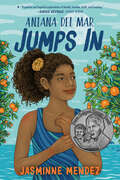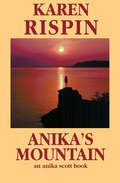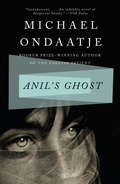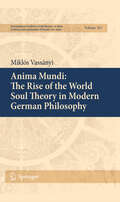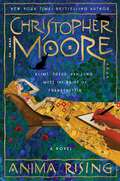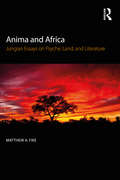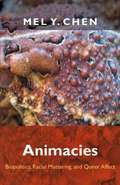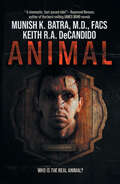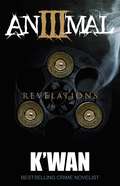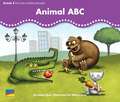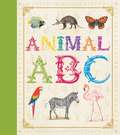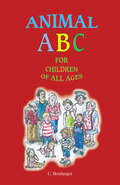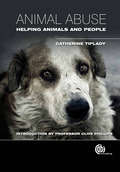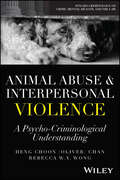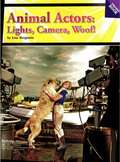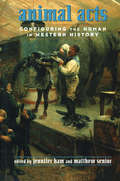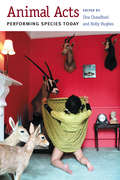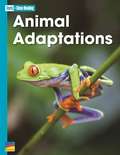- Table View
- List View
Ani's Raw Food Kitchen: Easy, Delectable Living Foods Recipes
by Ani PhyoThis is the ultimate gourmet, living foods "uncookbook" for busy people. You don't have to sacrifice taste or style to reap the benefits of raw foods. These delectable, easy recipes emphasize fresh, animal-free ingredients and how to include more organics into your daily diet. Chef Ani offers delicious raw, animal-free versions of: breakfast scrambles, pancakes, chowders, bisques, and other soups, cheezes, mylks, lasagna, burgers, cobblers, pies, and cakes, and more. Included are recipes for dishes such as Stuffed Anaheim Chili with Mole Sauce, Ginger Almond Nori Roll, Coconut Kreme Pie with Carob Fudge on Brownie Crust, Mediterranean Dolmas, and Chicken-Friendly Spanish Scramble. Make your own kitchen more living-foods friendly with Chef Ani's tips on Essential tools, Key ingredients, Stocking your pantry, and How-to kitchen skills.
Aniana del Mar Jumps In
by Jasminne MendezPura Belpré Author Honor Award** Four starred reviews!**A powerful and expertly told novel in verse about a twelve-year-old Dominican American swimmer who is diagnosed with Juvenile Arthritis by an award-winning poet.Aniana del Mar belongs in the water like a dolphin belongs to the sea. But she and Papi keep her swim practices and meets hidden from Mami, who has never recovered from losing someone she loves to the water years ago. That is, until the day Ani&’s stiffness and swollen joints mean she can no longer get out of bed, and Ani is forced to reveal just how important swimming is to her. Mami forbids her from returning to the water but Ani and her doctor believe that swimming along with medication will help Ani manage her disease. What follows is the journey of a girl who must grieve who she once was in order to rise like the tide and become the young woman she is meant to be. Aniana Del Mar Jumps In is a poignant story about chronic illness and disability, the secrets between mothers and daughters, the harm we do to the ones we love the most—and all the triumphs, big and small, that keep us afloat."Beautiful in its honesty and vulnerability, this is a powerful story about dreams and bodily agency that sings from the heart.&”—Natalia Sylvester, award-winning author of Breathe and Count Back From Ten
Aniela Kaminski's Story: A Voyage from Poland during World War II (Journey to America Series)
by Clare PastoreThey left their homelands during the worst moments in history and arrived in America ready to reach for their dreams. These are their stories... Dear Jadzia,I thought Papa and I would never make it out of Poland. I was afraid the Nazis would find us and send us to jail. After Stefan was arrested, I knew it could happen to us, too. Do you have any news of him? I hope and pray that he is safe. And Edith, too. It makes me angry to think that people hate her just because she is Jewish. You would love America. Life is so much better here. We are staying with my aunt and uncle in a city called Chicago, and there is lots of good food to eat. And guess what? I might even start taking piano lessons again! I wish you were here, Jadzia. I miss you so very much... Your friend, Aniela
Anika's Mountain (Anika Scott #3)
by Karen RispinBeing twelve isn't easy. But Anika Scott, who has joined her parents as a missionary in Kenya, uses her faith and trust in God and His words as guidance to help her through her adolescent problems. Join Anika in her exciting and often dangerous adventures where using God and her own ingenuity she makes discoveries about the truth in the world. Anika has always wanted to climb Mount Kenya and when Lisa gets to go with her Uncle Joey, Anika seizes the chance of a lifetime. But what is supposed to be the ultimate adventure in mountain climbing quickly turns disastrous. Will her prayers to God be answered in time or will her adventure on Mount Kenya turn deadly?
Anil's Ghost
by Michael OndaatjeFollowing the phenomenal success of Michael Ondaatje's Booker Prize-winning third novel,The English Patient, expectations were almost insurmountable. The internationally acclaimed #1 bestseller had made Ondaatje the first Canadian novelist ever to win the Booker. Four years later, in 1996, a motion picture based on the book brought the story to a vast new audience. The film, starring Ralph Fiennes and Juliette Binoche, went on to win numerous prizes, among them nine Academy Awards, including Best Picture. Worldwide English-language sales of the book topped two million copies. But in April 2000,Anil's Ghostwas widely hailed as Ondaatje's most powerful and engrossing novel to date. Winning a Governor General's Literary Award for Fiction, the Kiriyama Pacific Rim Book Prize and the Giller Prize,Anil's Ghostbecame an international bestseller. "Nowhere has Ondaatje written more beautifully," saidThe New York Times Book Review. The setting is Sri Lanka. Steeped in centuries of cultural achievement and tradition, the country has been ravaged in the late twentieth century by bloody civil war. As inThe English Patient, Ondaatje's latest novel follows a woman's attempt to piece together the lost life of a victim of war. Anil Tissera, born in Sri Lanka but educated in England and the U. S. , is sent by an international human rights group to participate in an investigation into suspected mass political murders in her homeland. Working with an archaeologist, she discovers a skeleton whose identity takes Anil on a fascinating journey that involves a riveting mystery. What follows, in a novel rich with character, emotion, and incident, is a story about love and loss, about family, identity and the unknown enemy. And it is a quest to unlock the hidden past - like a handful of soil analyzed by an archaeologist, the story becomes more diffuse the farther we reach into history. A universal tale of the casualties of war, unfolding as a detective story, the book gradually gives way to a more intricate exploration of its characters, a symphony of loss and loneliness haunted by a cast of solitary strangers and ghosts. The atrocities of a seemingly futile, muddled war are juxtaposed against the ancient, complex and ultimately redemptive culture and landscape of Sri Lanka. Anil's Ghostis Michael Ondaatje's first novel to be set in the country of his birth. "There's a tendency with us in England and North America to say it's a book 'about Sri Lanka. ' But it's just my take on a few characters, a personal tunnelling into that ... The book's not just about Sri Lanka; it's a story that's very familiar in other parts of the world" - in Africa, in Yugoslavia, in South America, in Ireland. "I didn't want it to be a political tract. I wanted it to be a human study of people in the midst of fear. "
Anima Mundi
by Don NigroDrama \ 8m, 5f (with doubling). \ Unit set. \ A young American poet arrives in London at the turn of the century, falls in love with a troubled dancer and has his fortune told by Madame Blavatsky. Each tarot card triggers a vivid scene from his turbulent future. Yeats in the tower, the Satanist Alister Crowley, and cranky Ezra Pound in the mad house are there as well as Oscar Wilde among some French ladies of easy virtue, a shell shocked Everett in no man's land, the bitter ballplayer Rex, and the manic Captain Blood. At a wild seance, Wilde's ghost is summoned to discuss God and chocolate eclairs. This poetic play traces the young American's search for his elusive love, God and the meaning of art in a stunning tapestry of memories and nightmares. A National Play Award finalist, this magical drama is central to the author's cycle of Pendragon plays.
Anima Mundi: The Rise Of The World Soul Theory In Modern German Philosophy (International Archives of the History of Ideas Archives internationales d'histoire des idées #202)
by Miklós VassányiThis work presents and philosophically analyzes the early modern and modern history of the theory concerning the soul of the world, anima mundi. The initial question of the investigation is why there was a revival of this theory in the time of the early German Romanticism, whereas the concept of the anima mundi had been rejected in the earlier, classical period of European philosophy (early and mature Enlightenment). The presentation and analysis starts from the Leibnizian-Wolffian school, generally hostile to the theory, and covers classical eighteenth-century physico-theology, also reluctant to accept an anima mundi. Next, it discusses early modern and modern Christian philosophical Cabbala (Böhme and Ötinger), an intellectual tradition which to some extent tolerated the idea of a soul of the world. The philosophical relationship between Spinoza and Spinozism on the one hand, and the anima mundi theory on the other is also examined. An analysis of Giordano Bruno's utilization of the concept anima del mondo is the last step before we give an account of how and why German Romanticism, especially Baader and Schelling asserted and applied the theory of the Weltseele. The purpose of the work is to prove that the philosophical insufficiency of a concept of God as an ens extramundanum instigated the Romantics to think an anima mundi that can act as a divine and quasi-infinite intermediary between God and Nature, as a locum tenens of God in physical reality.
Anima Rising: A Novel
by Christopher MooreFrom New York Times bestselling author Christopher Moore comes a hilariously deranged tale of a mad scientist, a famous painter, and an undead woman’s electrifying journey of self-discovery.Vienna, 1911. Gustav Klimt, the most famous painter in the Austrian Empire, the darling of Viennese society, spots a woman’s nude body in the Danube canal. He knows he should summon a policeman, but he can’t resist stopping to make a sketch first. And as he draws, the woman coughs. She’s alive!Back at his studio, Klimt and his model-turned-muse Wally tend to the formerly-drowned girl. She’s nearly feral and doesn’t remember who she is, or how she came to be floating in the canal. Klimt names her Judith, after one of his most famous paintings, and resolves to help her find her memory.With a little help from Sigmund Freud and Carl Jung, Judith recalls being stranded in the arctic one hundred years ago, locked in a crate by a man named Victor Frankenstein, and visiting the Underworld.So how did she get here? And why are so many people chasing her, including Geoff, the giant croissant-eating devil dog of the North?Poor Things meets Bride of Frankenstein in Anima Rising, Christopher Moore’s most ingenious (and probably most hilarious) novel yet.
Anima and Africa: Jungian Essays on Psyche, Land, and Literature
by Matthew A. FikeC. G. Jung understood the anima in a wide variety of ways but especially as a multifaceted archetype and as a field of energy. In Anima and Africa: Jungian Essays on Psyche, Land, and Literature, Matthew A. Fike uses these principles to analyze male characters in well-known British, American, and African fiction. Jung wrote frequently about the Kore (maiden, matron, crone) and the "stages of eroticism" (Eve, Mary, Helen, Sophia). The feminine principle’s many aspects resonate throughout the study and are emphasized in the opening chapters on Ernest Hemingway, Henry Rider Haggard, and Olive Schreiner. The anima-as-field can be "tapped" just as the collective unconscious can be reached through nekyia or descent. These processes are discussed in the middle chapters on novels by Laurens van der Post, Doris Lessing, and J. M. Coetzee. The final chapters emphasize the anima’s role in political/colonial dysfunction in novels by Barbara Kingsolver, Chinua Achebe/Nadine Gordimer, and Aphra Behn. Anima and Africa applies Jung’s African journeys to literary texts, explores his interest in Haggard, and provides fresh insights into van der Post’s late novels. The study discovers Lessing’s use of Jung’s autobiography, deepens the scholarship on Coetzee’s use of Faust, and explores the anima’s relationship to the personal and collective shadow. It will be essential reading for academics and scholars of Jungian and post-Jungian studies, literary studies, and postcolonial studies, and will also appeal to analytical psychologists and Jungian psychotherapists in practice and in training.
Anima: A Wild Pastoral
by Kapka KassabovaIn Anima, Kapka Kassabova introduces us to the “pastiri” people—the shepherds struggling to hold on to an ancient way of life in which humans and animals exist in profound interdependence. Following her three previous books set in the Balkans, and with an increasinging interest in the degraded state of our planet and culture, Kassabova reaches further into the spirit of place than she ever has before. In this extraordinary portrayal of pastoral life, she investigates the heroic efforts to sustain the oldest surviving breeds of our domesticated animals, and she shows us the epic, orchestrated activity of transhumance—the seasonal movement, on foot, of a vast herd of sheep, working in tandem with dogs. She also becomes more and more attuned to the isolation and sacrifices inherent in the lives shaped by this work.Weaving together lyrical writing about place with a sweeping sense of the traumatic histories that have shaped this mountainous region of Bulgaria, Kassabova shows how environmental change and industrial capitalism are endangering older, sustainable ways of living, and by extension she reveals the limited nature of so much of modern life. But shining through Kassabova’s passionate, intimate response to the monoculture that is “Anthropos” is her indelible portrait of a circulating interdependence of people and animals that might point to a healthier way to live.
Animacies: Biopolitics, Racial Mattering, and Queer Affect (Perverse Modernities: A Series Edited by Jack Halberstam and Lisa Lowe Ser.)
by Mel Y. ChenIn Animacies, Mel Y. Chen draws on recent debates about sexuality, race, and affect to examine how matter that is considered insensate, immobile, or deathly animates cultural lives. Toward that end, Chen investigates the blurry division between the living and the dead, or that which is beyond the human or animal. Within the field of linguistics, animacy has been described variously as a quality of agency, awareness, mobility, sentience, or liveness. Chen turns to cognitive linguistics to stress how language habitually differentiates the animate and the inanimate. Expanding this construct, Chen argues that animacy undergirds much that is pressing and indeed volatile in contemporary culture, from animal rights debates to biosecurity concerns. <P><P>Chen's book is the first to bring the concept of animacy together with queer of color scholarship, critical animal studies, and disability theory. Through analyses of dehumanizing insults, the meanings of queerness, animal protagonists in recent Asian/American art and film, the lead in toys panic in 2007, and the social lives of environmental illness, Animacies illuminates a hierarchical politics infused by race, sexuality, and ability. In this groundbreaking book, Chen rethinks the criteria governing agency and receptivity, health and toxicity, productivity and stillness—and demonstrates how attention to the affective charge of matter challenges commonsense orderings of the world.
Animal
by Keith R.A. DeCandido Munish K. BatraA serial killer targets those who harm innocent animals—poachers, big-game hunters, gourmet food companies, brutal animal trainers, dog fighters—and his kills are ramping up. Three detectives team up to discover the killer's identity before he strikes again—but are these truly acts of horror, or justice for the worst kind of people? Who is the real animal?
Animal (The\boundaries Ser. #3)
by Lexxie CouperDanger lurks in the farthest reaches of space, where sex is a reward and a weapon, alien drug lords blight the landscape, and assassination is a means to an end. Animal by award winning sci-fi paranormal author Lexxie Couper, is Book 3 of The Boundaries series. Get ready for another thrilling ride to distant planets, where the lines between friend and foe are blurred.The stunning conclusion to The Boundaries trilogy begins...The brutal crime lord Hrung Crortek has seized Terran Boundary Guardian Zeric Arctos, hoping to extract Zeric's werewolf DNA for use in an illegal genetic serum. Now Jaienna Ti, Intel-Patrol Corp agent and sexual assassin, is on a mission to wipe Crortek from existence-and she's taking her ex-partner Raq Tornada along for the ride!But when Tornada finally reveals-in no uncertain terms-how deeply he's in love with her, Jaienna faces a completely unexpected conflict: does she stay with the man who first shattered her heart, or does she go with the man who taught her to love again-the brooding, untameable werewolf she's trying so desperately to save?When lust, love, and longing become inextricably entwined, the Outer Boundaries become more dangerous than ever. Because Jaienna never planned on losing her heart to two men. And those two men never ever planned on sharing her. But unless Raq Tornada agrees to help Jaienna rescue his rival, Zeric Arctos is already doomed...This erotic sci-fi paranormal romance contains wild explosive sex in space, and is not intended for readers under the age of 18.Previously Published: (2011) 5x5 Publishing
Animal 2: Revelations
by K'WanAfter the incredible success of Animal, K'wan is back with the second, bloody installment in the new Animal saga. Secrets are revealed, sides are chosen and bodies are dropped...it's on!The man ordered to take Animal from the world turns out to be the man who brought him into it. Animal finds himself torn between his hatred for the father who had abandoned him and the man who had taken everything from him. An uneasy truce is formed between father and son to take down a common enemy and finally grant Animal his freedom from the blood debt he's carried for so many years. But when the ghosts of Animal's past catch up with him he learns that nothing is what it seems, and everything is subject to corruption, even his love for Gucci.
Animal 4.5 (Animal Ser.)
by K'wan''K'wan does a masterful job of keeping readers on their toes right up to the very last page.'-Publishers Weekly Animal 4 Re-Issue featuring Bonus material. From the moment Animal's former lover Red Sonja showed up on his doorstep, he knew trouble wouldn't be far behind. It wasn't because the last time he'd seen her, he had been fleeing for his life from a strange island. Nor was it because of the little girl she had in tow, claiming Animal was the father. It was because women like Red Sonja carried trouble around with them like designer purses. He knew getting involved with Sonja again would come at a price, but he had no idea how steep the price would be until it was too late. With his wife gone and his children abducted by a ruthless drug cartel, Animal must lead a suicide mission into the lair of one of the most dangerous assassins in the world, a woman who calls herself Tiger Lily. To go against Tiger Lily and the cartel Animal would need an army, so the call to arms is put out and the streets readily answer. Leading a handful of loyal souls against seemingly insurmountable odds, Animal races against the clock to save his children and put a stop to Tiger Lily and the cartel's plans, while trying to stay one step ahead of the two detectives following the trail of bodies. Things take an unexpected turn when Animal learns a dark truth hidden beneath what he had been led to believe that changes everything, including who can be trusted. When the Grand Design his father had always spoken of is finally revealed Animal will be forced to make the hard choice between love, loyalty, and vengeance.
Animal ABC
by Cindy Peattie Laura RuizSingle title not for individual sale. Sold as part of larger package only.
Animal ABC
by Susi MartinAn introduction to the alphabet and the animal kingdom. This charming book introduces children to every letter in the alphabet. Beautiful watercolor illustrations on every page will engage and delight children, with a variety of animals for children to spot, from aardvarks and alligators to zebras. Children love animals and take pride in identifying them. Animal ABC is sure to engage young minds.
Animal ABC for Children of All Ages
by C. BoulangerWhen COVID-19 lockdowns swept the globe, creativity unlocked for one woman in Belleville, Ontario. Alone with her cat, C. Boulanger turned to a fantasy world she had long imagined, bringing to life a charming children&’s tale. With whimsical animals as guides straight from her isolation, she penned Animal ABC for Children of All Ages not just to delight young readers, but to remind all of us that even in the darkest of days, joy and wonder still exist if only we know where to look. Brighten your family&’s time at home with this playful journey of imagination.Cover designed by Janet Eastwood.
Animal Abuse
by Catherine TipladyAnimal abuse affects everybody working in animal-related industries, and constitutes a significant part of veterinary caseloads and animal shelter work. Based on the author's experience as a shelter worker and veterinarian, this book provides advice and assistance to those working with animal abuse. Beginning with definitions and types of abuse that occur worldwide in domestic, industry, leisure and cultural settings, the book goes on to detail current topics of debate such as foie gras production, pedigree dog breeding, links between animal abuse and domestic violence, and the fascinating subject of veterinary forensics - the scientific investigation of instances of animal abuse. The book's practical focus is developed through interviews with people in a variety of affected roles, international case studies, and discussion of the difficulties that arise; how they can be dealt with and the mental health impacts they can have on those involved. With contributions from world-renowned experts including Phil Arkow and David Bailey, and an introduction by Clive Phillips, Animal Abuse: Helping Animals and People provides practical advice and insights into issues surrounding this emotional subject.
Animal Abuse and Interpersonal Violence: A Psycho-Criminological Understanding (Psycho-Criminology of Crime, Mental Health, and the Law)
by Heng Choon Oliver Chan Rebecca W. Y. WongANIMAL ABUSE & INTERPERSONAL VIOLENCE A COMPREHENSIVE EXAMINATION OF THE CAUSES OF, AND LINKS BETWEEN, INTERPERSONAL AND INTERSPECIES VIOLENCE Animal Abuse & Interpersonal Violence: A Psycho-Criminological Understanding addresses the many aspects of the link between animal cruelty and human violence. Presenting new theory, research, policy, and practice, this authoritative volume explores the subject through a psycho-criminological lens to describe, explain, and potentially prevent intentional behavior that causes pain, suffering, or death in animals and humans. With an integrated theoretical-practical approach, Animal Abuse & Interpersonal Violence offers up-to-date research and provides real-world insights into current thinking in the study of animal abuse and interpersonal violence. Sixteen in-depth chapters by a multidisciplinary team of active researchers and experienced field practitioners examine central topics in the field, including different forms of animal exploitation, connections between animal cruelty and substance abuse, the association between childhood animal cruelty and adult interpersonal violence, the role of veterinarians in the identification of animal abuse cases, the complex legal aspects of animal abuse cases, and more. Advances scholarship on animal abuse, its relationship with interpersonal violence, and the psycho-criminological mechanisms involved in that relationship Introduces readers to contemporary research on a range of topics and issues related to animal abuse and interpersonal violence Examines the origins of animal cruelty, its societal implications, and various prevention and treatment approaches Defines and describes various types of animal maltreatment and their links to different forms of interpersonal violence Animal Abuse & Interpersonal Violence: A Psycho-Criminological Understanding is essential reading for practitioners, researchers, scholars, and advanced students in fields such as behavioral science, law, criminology, veterinary forensics, criminal justice, law enforcement, social work, sociology, social sciences, education, and animal welfare.
Animal Abuse: Helping Animals and People
by Catherine TipladyAnimal abuse affects everybody working in animal-related industries, and constitutes a significant part of veterinary caseloads and animal shelter work. Based on the author's experience as a shelter worker and veterinarian, this book provides advice and assistance to those working with animal abuse. Beginning with definitions and types of abuse that occur worldwide in domestic, industry, leisure and cultural settings, the book goes on to detail current topics of debate such as foie gras production, pedigree dog breeding, links between animal abuse and domestic violence, and the fascinating subject of veterinary forensics - the scientific investigation of instances of animal abuse. The book's practical focus is developed through interviews with people in a variety of affected roles, international case studies, and discussion of the difficulties that arise; how they can be dealt with and the mental health impacts they can have on those involved. With contributions from world-renowned experts including Phil Arkow and David Bailey, and an introduction by Clive Phillips, Animal Abuse: Helping Animals and People provides practical advice and insights into issues surrounding this emotional subject.
Animal Actors: Lights, Camera Wolf! / Animals in Film: Cruelty on Camera (Fountas & Pinnell LLI Purple #Level W)
by Lisa BenjaminTWO WAY BOOK Animal Actors Lights Camera Wolf! & Animals in Film Cruelty on Camera by Lisa Benjamin
Animal Acts: Configuring the Human in Western History
by Jennifer Ham Matthew SeniorAnimal Acts records the history of the fluctuating boundary between animals and humans as expressed in literary, philosophical and scientific texts, as well as visual arts and historical practices such as dissection, circus acts, the hunt and zoos. The essays document a persistent return of animality, a becoming animal that has always existed within and at the margins of Western Culture from the Middle Ages to the present.
Animal Acts: Performing Species Today
by Holly Hughes Una ChaudhuriWe all have an animal story--the pet we loved, the wild animal that captured our childhood imagination, the deer the neighbor hit while driving. While scientific breakthroughs in animal cognition, the effects of global climate change and dwindling animal habitats, and the exploding interdisciplinary field of animal studies have complicated things, such stories remain a part of how we tell the story of being human. Animal Acts collects eleven exciting, provocative, and moving stories by solo performers, accompanied by commentary that places the works in a broader context. Work by leading theater artists Holly Hughes, Rachel Rosenthal, Deke Weaver, Carmelita Tropicana, and others joins commentary by major scholars including Donna Haraway, Jane Desmond, Jill Dolan, and Nigel Rothfels. Una Chaudhuri's introduction provides a vital foundation for understanding and appreciating the intersection of animal studies and performance. The anthology foregrounds questions of race, gender, sexuality, class, nation, and other issues central to the human project within the discourse of the "post human," and will appeal to readers interested in solo performance, animal studies, gender studies, performance studies, and environmental studies.

